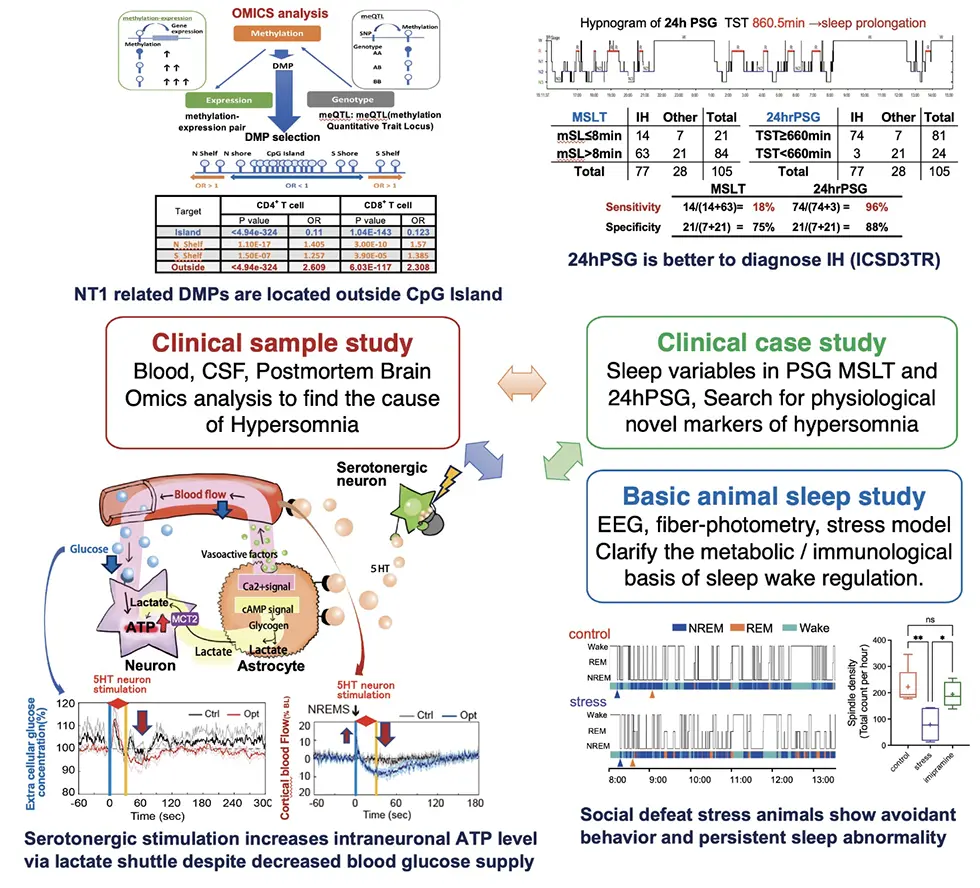
- HOME
- Sleep Disorders Project
Sleep Disorders Project
Multifaceted Approaches to Elucidating Sleep Disorder Pathophysiology and Establishing a Diagnostic and Therapeutic Framework
Achievements in 2024
We continue to recruit clinical cases suspected of hypersomnia (total >1000) with PSG-MSLT data and DNA sample. By omics analysis we identified fatty acid/metabolic abnormalities in NT1 and IH and global hypomethylation in NT1
We organized diagnostic 3-day sleep study system comprising of 24hPSG-PSG-MSLT and found 24hPSG is better test to detect IH patients.
Animal sleep study demonstrated that serotonergic stimulation increases intraneuronal ATP level during Wake by two pathways. We also identified persistent sleep dysregulation in animal with social defeat stress.

Publications
Papers in 2024
- Natsubori A et al Serotonergic regulation of cortical neurovascular coupling and hemodynamics upon awakening from sleep in mice. J Cereb Blood Flow Metab 271678X24128843.
- Matsuda Y et al Physiological paradigm for assessing reward prediction and extinction using cortical direct current potential responses in rats. Sci Rep14:10422.
- Shimada M et al Identification of region-specific gene isoforms in the human brain using long-read ttranscriptome sequencing. Sci Adv 10 eadj529
Key papers
- Natsubori A et al. (2023) Serotonergic neurons control cortical neuronal intracellular energy dynamics by modulating astrocyte-neuron lactate shuttle iScience 26, 105830,
- Miyagawa T, et al (2022) A rare genetic variant in the cleavage site of prepro-orexin gene is associated with idiopathic hypersomnia. npj Genomic Medicine 7:29
- Honda M, et al (2022) Low carnitine palmitoyltransferase 1 activity is a risk factor for narcolepsy type 1 and other hypersomnia. Sleep 45:zsac160
- Honda M, et al (2021) Evaluation of pathological sleepiness by Multiple Sleep Latency Test and 24-hour polysomnography in patients suspected of idiopathic hypersomnia. Psychiatry Clin Neurosci 75:149-151
- Natsubori A, et al (2020) In vivo state-dependent dynamics of cellular energy status in cortical neurons. Communications Biol 3: 491
- Shimada M, et al (2020) Epigenome-wide association study of narcolepsy-affected lateral hypothalamic brain and overlapping DNA methylation profiles between narcolepsy and multiple sclerosis. Sleep 43:zsz198
- Shimada M, et al (2020) Metabolome analysis using cerebrospinal fluid from narcolepsy type 1 patients. Sleep. 43:zsaa095.
